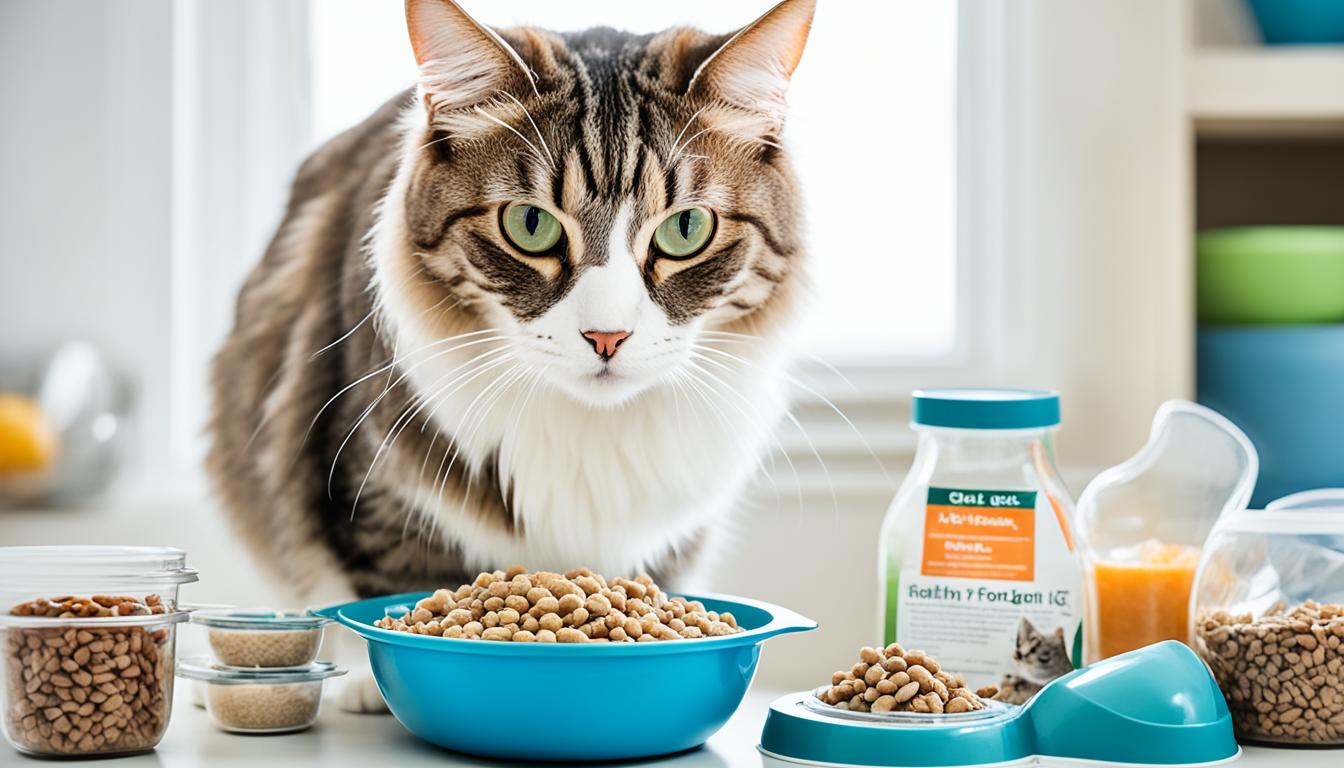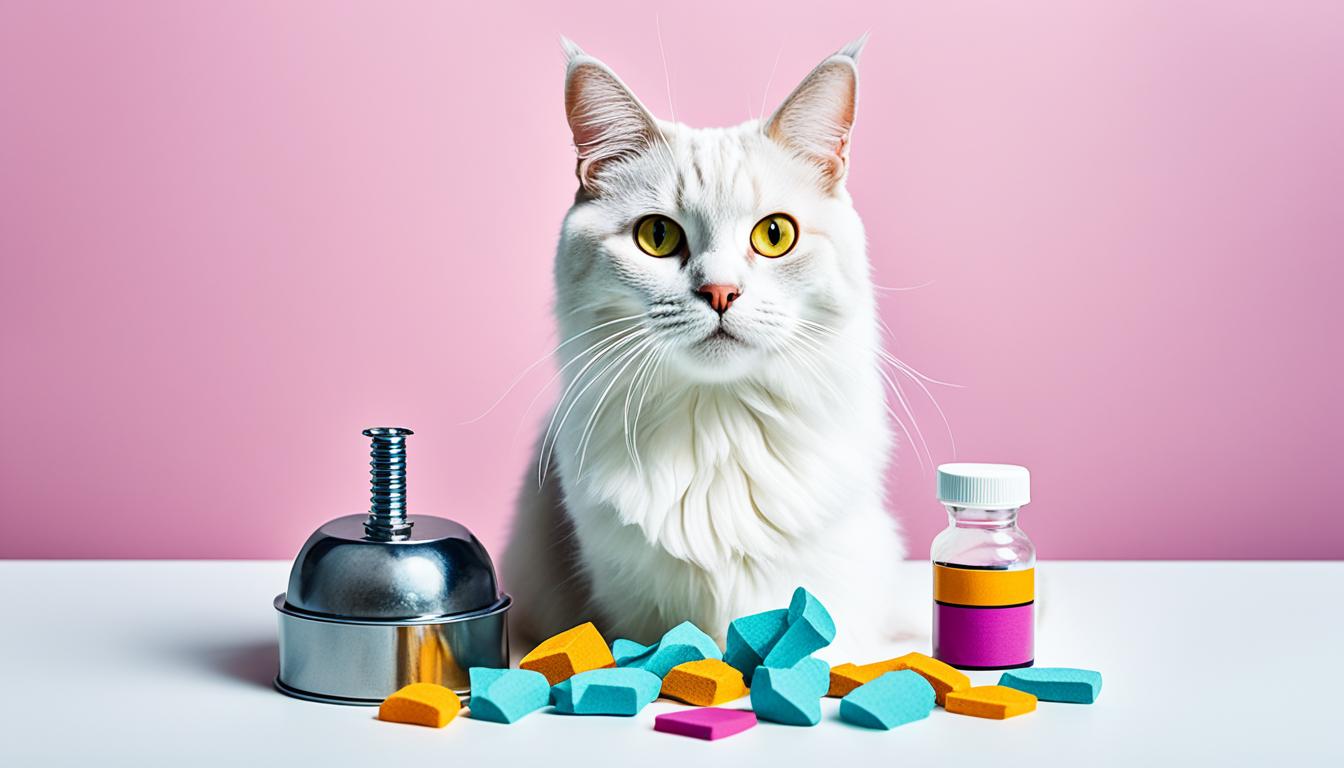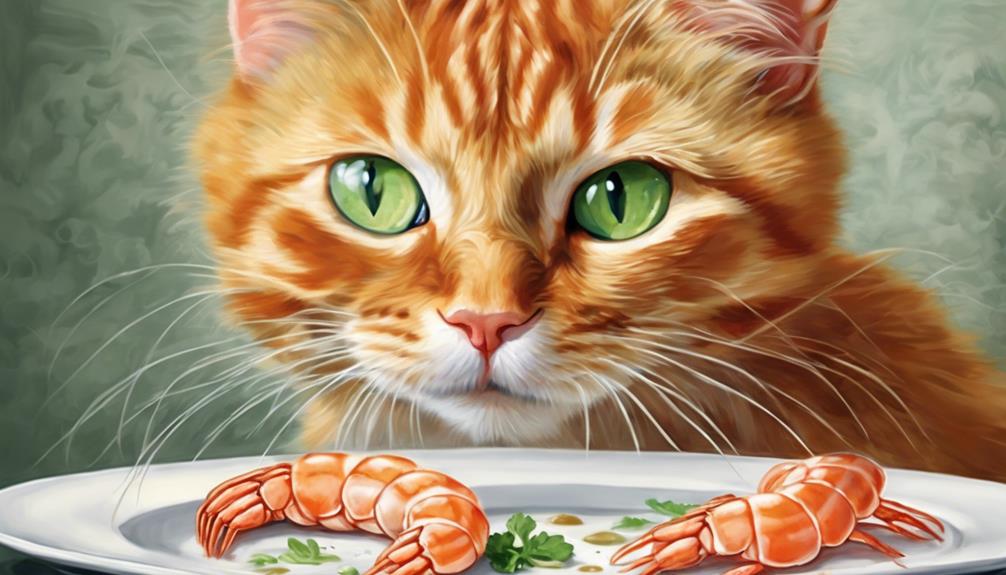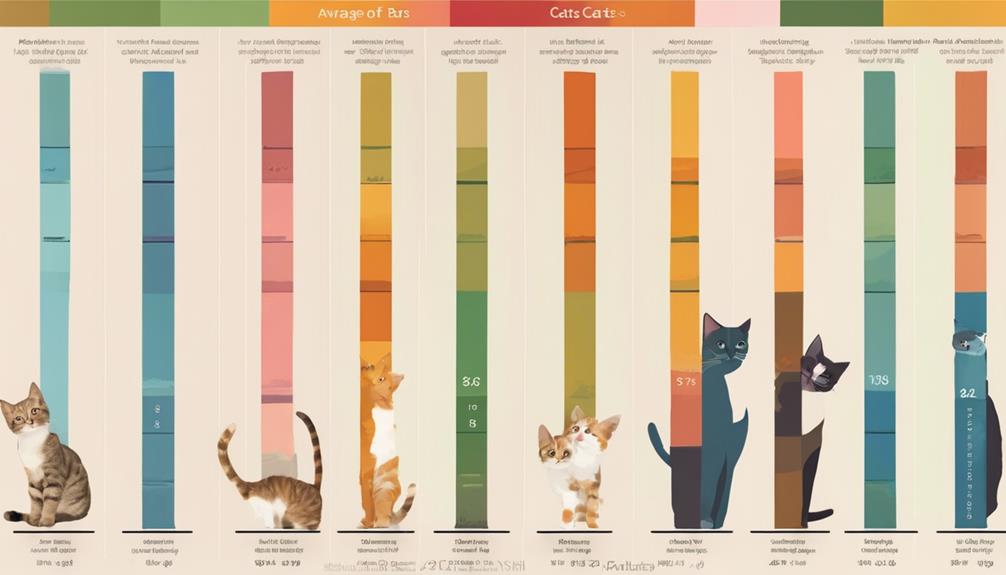Were you aware that more than 60% of cats in the United States are overweight or obese? Translated to US English: Were you aware that more than 60% of cats in the United States are overweight or obese?
Feeding your cat the right amount of food is crucial for their overall health and well-being. Determining how much to feed your cat can be challenging, as it depends on various factors such as age, weight, activity level, and lifestyle. To ensure that you are providing your feline friend with the correct portion size, it is essential to consider these factors and consult with a veterinarian.
Key Takeaways:
- Over 60% of cats in the United States are overweight or obese.
- Determining the right portion size for your cat depends on factors such as age, weight, activity level, and lifestyle.
- Consulting with a veterinarian is recommended to ensure your cat’s nutritional needs are met.
- Monitoring your cat’s eating habits and body condition is crucial for maintaining their ideal body weight.
- Dividing your cat’s total daily food intake into multiple small meals throughout the day is recommended.
Factors to Consider When Feeding Your Cat
When it comes to feeding your cat, it’s important to take into account several factors that can affect their dietary needs. These factors include their age, breed, size, activity level, reproductive status, health status, and whether they live an indoor or outdoor lifestyle. Each of these factors plays a role in determining the appropriate portion size and nutritional requirements for your cat.
Let’s take a closer look at how each of these factors can impact your cat’s feeding habits:
- Age: Kittens and senior cats have different nutritional requirements compared to adult cats. Kittens require more frequent meals and a diet rich in essential nutrients for growth and development. Senior cats, on the other hand, may require fewer calories to prevent weight gain.
- Breed: Some cat breeds have specific dietary needs due to their genetic predispositions. For example, certain breeds may be prone to obesity or have a higher risk of certain health conditions that require a specialized diet.
- Size: The size of your cat can also impact their feeding requirements. Larger cats may require more food to meet their energy needs, while smaller cats may need smaller portions to prevent overfeeding.
- Activity Level: Cats with high activity levels, such as outdoor cats or those with active play routines, may require more calories to fuel their energy expenditure. Conversely, less active cats may need fewer calories to maintain a healthy weight.
- Reproductive Status: Intact female cats (not spayed) and pregnant or nursing cats may require additional calories and nutrients to support their reproductive functions and the growth of their offspring.
- Health Status: Cats with certain health conditions, such as diabetes or kidney disease, may require a specialized diet prescribed by a veterinarian. It’s crucial to work closely with your vet to determine the best feeding plan for your cat’s specific health needs.
- Indoor vs Outdoor Lifestyle: Outdoor cats tend to have higher energy requirements due to increased physical activity and exposure to the elements. Indoor cats, on the other hand, may have lower energy needs but may require environmental enrichment to prevent obesity and boredom.
By considering these various factors, you can tailor your cat’s diet to meet their individual needs and ensure they receive the appropriate nutrition for optimal health. Remember to consult with your veterinarian to develop a feeding plan that takes into account your cat’s unique characteristics and lifestyle.
How to Determine the Right Portion Size for Your Cat
When it comes to feeding your cat, determining the right portion size is essential. This ensures that your feline friend receives the proper nutrition without overeating or undernourishing. To help you in this process, we recommend following a cat feeding chart that takes into account your cat’s weight and age. This chart serves as a useful reference and provides guidelines for portion sizes tailored to your cat’s specific needs.
Another important factor to consider is calculating your cat’s calorie intake. Understanding their caloric needs can help you ensure they are receiving the appropriate amount of food for optimal health. To calculate your cat’s calorie intake, you can refer to the caloric content listed on the cat food label. This information allows you to determine the number of calories your cat needs in a day.
To convert these calories into portion sizes, it is crucial to consider the calorie density of the food. Different types of cat food, such as wet and dry, have varying calorie content. Wet cat food typically has a higher water content and lower calorie density compared to dry cat food. Therefore, when feeding wet cat food, larger portions may be necessary to meet your cat’s caloric needs.
To convert calories into portion sizes, you can divide the daily caloric intake by the calorie density of the food. This will give you an estimation of the appropriate portion size for your cat. Keep in mind that these calculations are a general guide, and individual cat’s needs may vary. Monitoring your cat’s weight and adjusting portion sizes as needed is essential to ensure they maintain a healthy body condition.
In summary, determining the right portion size involves consulting a cat feeding chart based on your cat’s weight and age, calculating their caloric intake using the information on the cat food label, and considering the calorie density of the food. By carefully measuring and monitoring your cat’s portions, you can provide them with a balanced diet that meets their nutritional needs.
Tips for Measuring Portion Sizes:
- Use a kitchen scale to accurately measure food by weight.
- Refer to the feeding guidelines provided on the cat food packaging.
- Divide the daily caloric intake into multiple meals to support your cat’s natural eating pattern.
- Monitor your cat’s weight and adjust portion sizes accordingly.
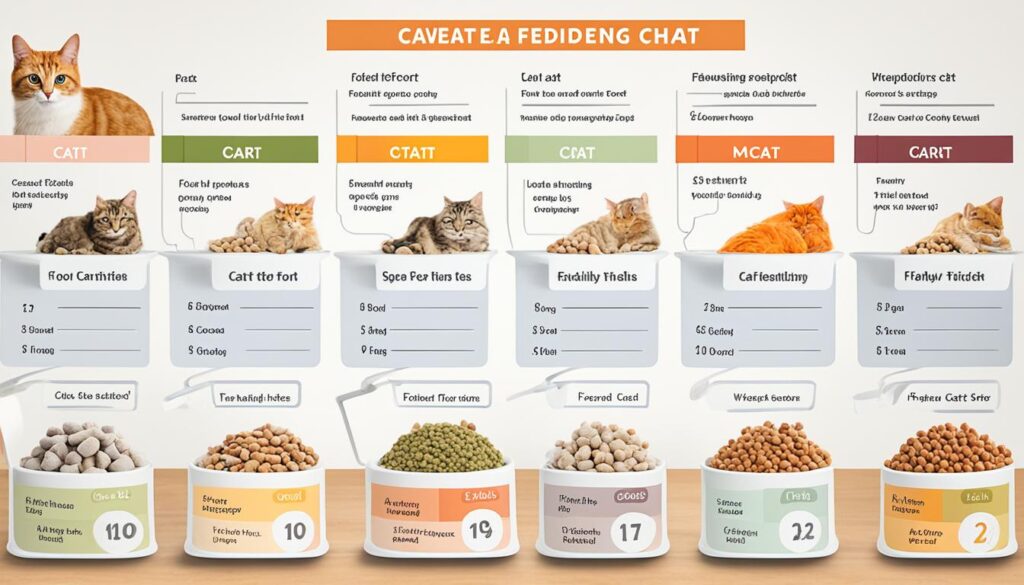
Sample Cat Feeding Chart:
| Weight Range | Dry Food (calories/day) | Wet Food (calories/day) |
|---|---|---|
| 5-8 lbs | 180-220 | 150-180 |
| 8-12 lbs | 220-270 | 180-220 |
| 12-16 lbs | 270-320 | 220-270 |
Feeding Schedule and Frequency
When it comes to feeding cats, establishing a regular feeding schedule is essential. Cats generally prefer multiple small meals throughout the day rather than one or two large meals. By dividing your cat’s total daily food intake into two or more meals, you can provide them with the nourishment they need while mimicking their natural feeding behavior.
One effective method to ensure your cat receives timely, measured meals is by using an automatic timed feeder. These feeders can be programmed to dispense food at scheduled intervals, even when you’re away from home. By utilizing this handy tool, you can maintain your cat’s feeding routine and prevent irregular feeding habits that could lead to overeating or obesity.
Automatic timed feeders offer several benefits for both you and your feline friend. They provide convenience by eliminating the need for manual feeding and allow you to regulate portion sizes more accurately. Additionally, automatic timed feeders promote portion control, which is crucial for maintaining your cat’s ideal body weight and overall health.
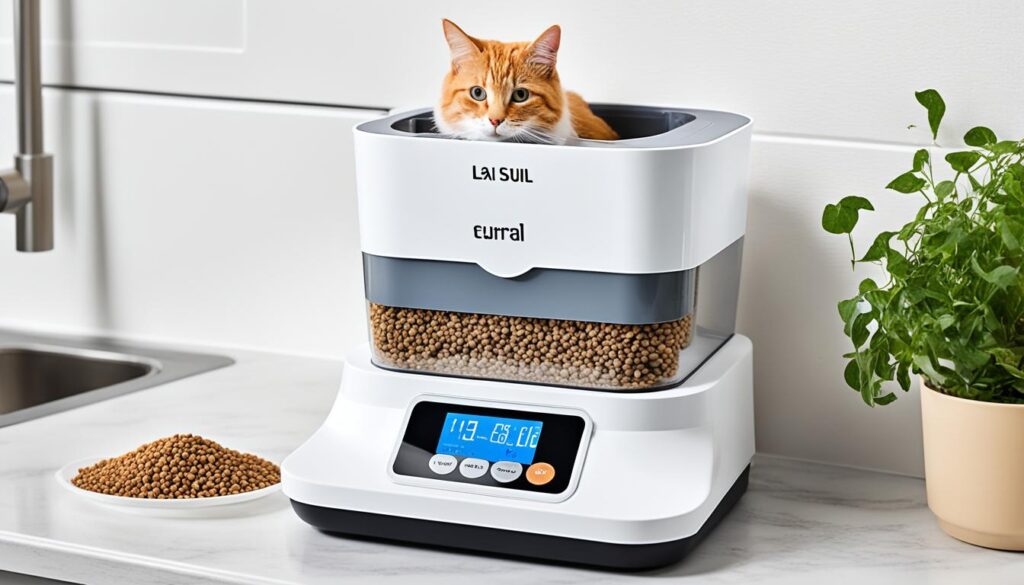
With an automatic timed feeder, you can set the frequency and timing of your cat’s meals based on their specific needs. This ensures that your cat is consistently receiving the right amount of food without the risk of overfeeding or underfeeding. It also helps establish a routine, which is beneficial for cats that thrive on structure and predictability.
However, it’s important to note that not all cats have the same feeding requirements. Factors such as age, weight, activity level, and overall health should be taken into consideration when determining the feeding schedule and frequency that works best for your cat. Consulting with a veterinarian is recommended to ensure you are meeting your cat’s specific nutritional needs.
Benefits of a Feeding Schedule
Adhering to a consistent feeding schedule can have several positive effects on your cat’s well-being:
- Prevents overeating and obesity: By offering measured portions at scheduled times, you can prevent your cat from overindulging and becoming overweight. Obesity in cats can lead to a variety of health issues, including diabetes, joint problems, and heart disease.
- Manages finicky eaters: Cats with picky eating habits may be more likely to eat regularly if they are accustomed to a set feeding schedule. This can reduce stress and ensure they receive the necessary nutrients.
- Promotes better digestion: Regular and consistent feeding can help regulate your cat’s digestive system, reducing the likelihood of gastrointestinal issues such as vomiting or constipation.
- Establishes a routine: Cats are creatures of habit and thrive on routine. By feeding them at the same times each day, you provide a sense of stability and security, which can contribute to their overall well-being.
By implementing a feeding schedule and utilizing an automatic timed feeder, you can ensure your cat’s nutritional needs are met while maintaining a healthy weight and promoting their overall happiness and vitality.
Conclusion
Feeding your cat the right amount of food is essential for maintaining their ideal body weight and overall health. To ensure you are providing the appropriate portion size, it is crucial to work closely with a veterinarian who can assess your cat’s specific needs. By understanding their unique factors such as age, weight, and activity level, your veterinarian can provide tailored recommendations for feeding.
Monitoring your cat’s eating habits and body condition is also important in maintaining their ideal weight. Pay attention to how much they are eating and look for any signs of weight gain or loss. Regular check-ups with your veterinarian can help you stay on top of your cat’s health and make any necessary adjustments to their diet.
Remember, there is no one-size-fits-all when it comes to cat feeding. Each cat is different, and it’s important to take into account their individual needs. By working together with your veterinarian and considering their eating habits, you can ensure that your cat is well-nourished, maintaining a healthy weight, and leading a happy, active life.
